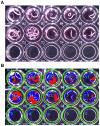WormAssay: a novel computer application for whole-plate motion-based screening of macroscopic parasites
- PMID: 22303493
- PMCID: PMC3269415
- DOI: 10.1371/journal.pntd.0001494
WormAssay: a novel computer application for whole-plate motion-based screening of macroscopic parasites
Abstract
Lymphatic filariasis is caused by filarial nematode parasites, including Brugia malayi. Adult worms live in the lymphatic system and cause a strong immune reaction that leads to the obstruction of lymph vessels and swelling of the extremities. Chronic disease leads to the painful and disfiguring condition known as elephantiasis. Current drug therapy is effective against the microfilariae (larval stage) of the parasite, but no drugs are effective against the adult worms. One of the major stumbling blocks toward developing effective macrofilaricides to kill the adult worms is the lack of a high throughput screening method for candidate drugs. Current methods utilize systems that measure one well at a time and are time consuming and often expensive. We have developed a low-cost and simple visual imaging system to automate and quantify screening entire plates based on parasite movement. This system can be applied to the study of many macroparasites as well as other macroscopic organisms.
Conflict of interest statement
The authors have declared that no competing interests exist.
Figures



 of (A) albendazole (
of (A) albendazole ( ), (B) ivermectin (
), (B) ivermectin ( ) and (C) fenbendazole (
) and (C) fenbendazole ( ) determined using the proposed method with compounds at concentrations of
) determined using the proposed method with compounds at concentrations of  ,
,  ,
,  ,
,  ,
,  and
and  .
.

References
-
- WHO. Lymphatic filariasis (factsheet). 2011. URL http://www.who.int/mediacentre/factsheets/fs102/en/
-
- Kotze A, Jambre LL, O'Grady J. A modified larval migration assay for detection of resistance to macrocyclic lactones in Haemonchus contortus, and drug screening with Trichostrongylidae parasites. Veterinary Parasitology. 2006;137:294–305. - PubMed
-
- Kotze AC, Clifford S, O'Grady J, Behnke JM, McCarthy JS. An in vitro larval motility assay to determine anthelmintic sensitivity for human hookworm and strongyloides species. The American Journal of Tropical Medicine and Hygiene. 2004;71:608–616. - PubMed
Publication types
MeSH terms
Substances
Grants and funding
LinkOut - more resources
Full Text Sources
Other Literature Sources

